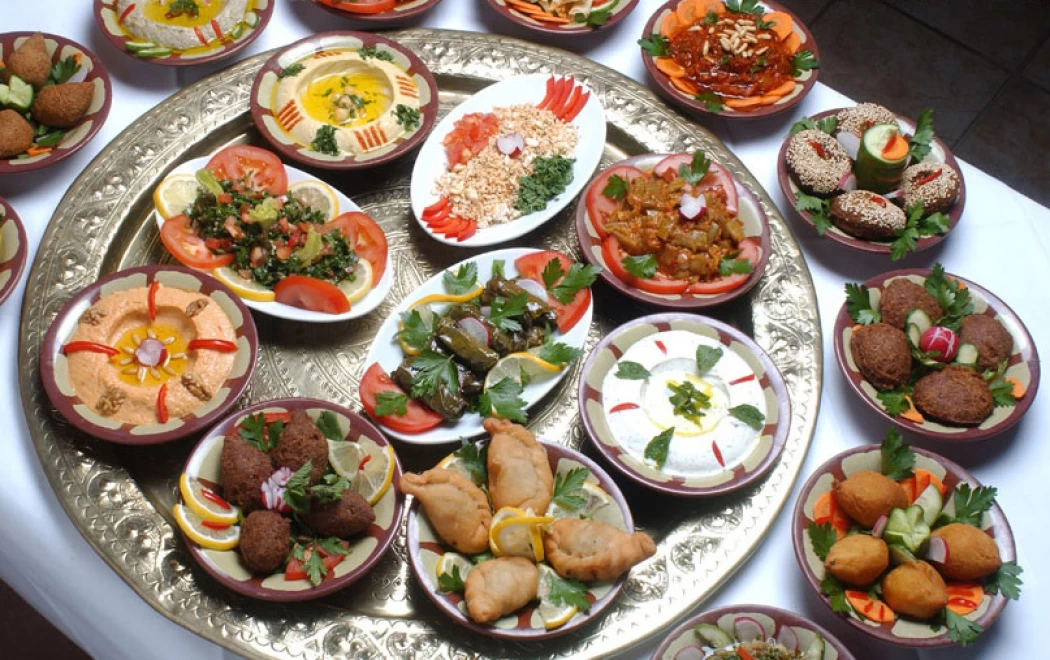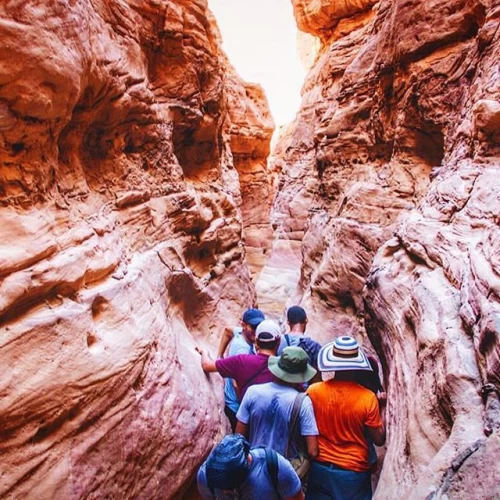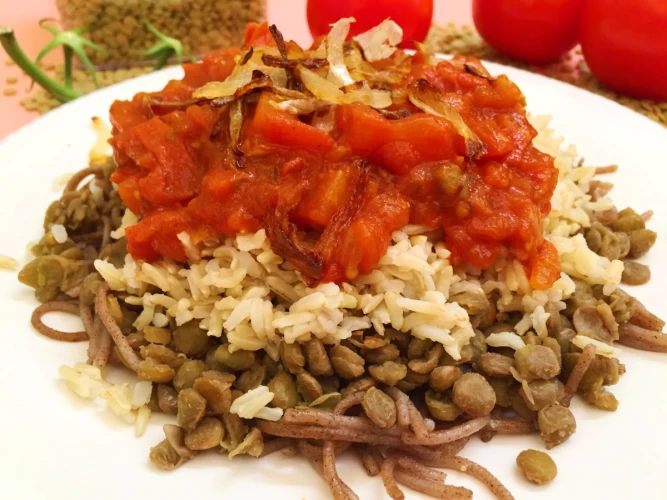
Ägyptische Küche
Ägyptische Küche
Sind Sie vollständig geimpft? Dann müssen Sie bei Ihrer Ankunft am internationalen Flughafen von Kairo keinen PCR-Test vorlegen, um einen einmaligen Urlaub im Land der Pharaonen zu genießen.
In der ägyptischen Küche werden häufig Hülsenfrüchte, Gemüse und Obst aus dem reichen ägyptischen Niltal und Delta verwendet. Es hat Ähnlichkeiten mit dem Essen des östlichen Mittelmeerraums, wie mit Reis gefülltes Gemüse, Weinblätter, Döner, Kebab und Kofta.
Beispiele für ägyptische Rezepte sind Ful Medames, bei denen es sich um zerdrückte Bohnen handelt. Kushari, Linsen und Nudeln; und Molokhia, Busch-Okra-Eintopf. Das Fladenbrot, das vor Ort als Eish Baladi bekannt ist, und die Käseherstellung in Ägypten stammen aus der 1. Dynastie Ägyptens, wobei Feta-Käse die am häufigsten konsumierte Käsesorte ist.
Da Ägypten das erste Landwirtschaftsland der Welt ist, ist die ägyptische Küche das gesündeste Gericht der Welt. Ihre Mahlzeit besteht aus Eiweiß, Vetgetable, Kohlenhydraten, Vitaminen und Eisen. Daher ist das Gericht eine vollkommen gesunde Mahlzeit
Gewöhnliches Fleisch in der ägyptischen Küche sind Kaninchen, Tauben, Hühnchen und Enten. Lamm und Rindfleisch werden normalerweise zum Grillen verwendet.
Falafel ist eines der bekanntesten Fastfoods in Kairo und die Desserts werden in der Region seit mindestens 2500 Jahren zubereitet. Neben Fisch und Meeresfrüchten, die in den Küstengebieten Ägyptens verbreitet sind, ist die Stadt Alexandria die bekannteste. Es gibt viel ägyptisches vegetarisches Essen, sowohl aufgrund des relativ hohen Fleischpreises als auch der Bedürfnisse der koptisch-christlichen Gemeinschaft, deren religiöse Einschränkungen im Wesentlichen eine vegetarische Ernährung während des größten Teils des Jahres erfordern.
Das Teegetränk ist das Nationalgetränk Ägyptens, wo die Ägypter auf vielfältige Weise gelernt haben, Tee zuzubereiten, wo man überall in einem örtlichen Café etwas trinken kann, vielleicht während Ihrer Spaziergänge in Kairo im Al Fishawy Café, und Kaffee kommt an zweiter Stelle, Bier ist das meiste beliebtes alkoholisches Getränk. Während Alkohol ein religiöses Tabu ist und engagierte Muslime und Kopten dazu neigen, alkoholische Getränke zu meiden, ist Alkohol im Land leicht erhältlich.
Beliebte Desserts in Ägypten sind Baklava, Sebousah, Konafa und Swabe 'Zeinab. Übliche Zutaten in Desserts sind Datteln, Honig und Mandeln.
Die ägyptische Küche neigt besonders zu vegetarischen Gerichten, da sie stark auf Bohnen und vegetarischen Gerichten beruht. Obwohl das Essen in Alexandria und den Küstenstädten in Ägypten tendenziell eine große Menge Fisch und andere Meeresfrüchte verwendet, unterscheidet sich die ägyptische Küche von Gouvernement zu Gouvernorat, hängt jedoch größtenteils von Lebensmitteln ab, die außerhalb des Landes wachsen.
Die ägyptischen Häfen am Roten Meer waren der erste Haupteinstiegspunkt für Gewürze aus Europa, da verschiedene Gewürze im Laufe der Jahre leicht zugänglich waren und diese Gewürze ihre Spuren in der ägyptischen Küche wie Kreuzkümmel hinterließen, der als eines der am häufigsten verwendeten Gewürze gilt. Andere übliche Gewürze sind Koriander, Chili, schwarzer Pfeffer, Anis, Lorbeerblätter, Dill, Ingwer, Zimt, Minze und Nelken.
Zu den in der ägyptischen Küche gebräuchlichen Fleischsorten zählen Kaninchen, Tauben, Geflügel und Enten. Es wird oft gekocht, um Brühe für verschiedene Suppen und Suppen zu machen. Lamm und Rindfleisch sind das am häufigsten beim Grillen verwendete Fleisch. Gegrilltes Fleisch wie Kofta (Kofta), Kebab (Kebab) und gegrillte Scheiben werden zeitweise als Grill bezeichnet.
Es ist beliebt in Ägypten, im Darm von Tieren und verschiedenen Fleischsorten. Die auf Alexandria spezialisierten Leber- und Sandwiches gehören zu den bekanntesten Fastfoods des Landes. Gehackte Leberstücke, gebraten mit Paprika, Paprika, Knoblauch, Kreuzkümmel und anderen Gewürzen, werden in baguetteähnlichem Brot namens Eish Fino serviert. In einigen Städten Ägyptens frisst es auch das Gehirn und die Schafe von Kühen.
Küche und religiöse Praxis:
Einer der Monate, in denen viele Aktivitäten stattfinden, ist der Monat Ramadan, der für Muslime in Ägypten der Monat des Fastens ist. In der Regel sind die Ägypter jedoch nach dem Frühstück von einer Menge Essenszubereitung geprägt, auf die sie achten die Vielfalt des Essens und sein Reichtum,
denn iftar ist eine Familienangelegenheit, und ganze Familien treffen sich oft auf dem Tisch, genau nach Sonnenuntergang, nach dem Maghrib-Gebet. Es gibt viele Desserts, die fast ausschließlich im Ramadan serviert werden, wie Kunafa (Kanafe) und Qatayef (Qatayef). In diesem Monat bereiten viele Ägypter einen speziellen Tisch für die Armen oder Umstehenden vor, normalerweise in einem Zelt auf der Straße,
der als Lehrassistent des Barmherzigen bezeichnet wird (ägyptisches Arabisch: Rahmans Tisch, was wörtlich übersetzt "Zeitplan der Barmherzigkeit" bedeutet) Für einen der 99 Namen Gottes kann dies etwas einfach oder etwas luxuriös sein, abhängig vom Reichtum und den Fähigkeiten seines Schöpfers.
Aufmerksame Christen in Ägypten halten sich an Fastenzeiten nach dem koptischen Kalender; Diese können sich für die extremsten und aufmerksamsten Personen praktisch auf mehr als zwei Drittel des Jahres erstrecken.
Die säkularere koptische Bevölkerung fastet hauptsächlich zu Ostern und Weihnachten. Die koptische Diät zum Fasten ist im Wesentlichen vegan. Während dieses Fastens essen Kopten normalerweise in Öl gebratenes Gemüse und Hülsenfrüchte und meiden Fleisch, Hühnchen und Milchprodukte, einschließlich Butter und Sahne.
Getränke:
Tee ist ein wichtiger Bestandteil des täglichen Lebens und der Folklore in Ägypten. Es wird normalerweise von einem Familienbesuch bei einer anderen Person begleitet, der sich mit dem Niveau der Sozialwirtschaft oder dem Zweck des Besuchs bei einer Tasse Tee befasst. Gastfreundschaft kann für Sie selbst erforderlich sein.
Der gebräuchliche Name für Tee in Ägypten ist "Pflicht" (auf Arabisch als "wa-jeb" oder "wa-geb" ausgesprochen), da das Servieren von Tee für einen Besucher eine Aufgabe ist, während alles andere schön ist.
Kaffee, Qahwa ägyptisches Arabisch: wird als Teil des traditionellen Willkommens in Ägypten angesehen. Es wird normalerweise in einer kleinen Kaffeekanne zubereitet, die in Ägypten Dallas genannt wird. Es wird in einer kleinen Tasse für Kaffee namens Fengan serviert. Der Kaffee wird normalerweise in unterschiedlichem Maße mit Zucker gesüßt; „Al riha, mazbout und ziyada plus sariaose. Ungesüßter Kaffee ist als Sada oder Plain bekannt.
In Ägypten wird Zuckerrohrsaft „Aseer Asab“ genannt und ist ein unglaublich beliebtes Getränk, das von fast allen Fruchtsaftverkäufern serviert wird, die in den meisten Städten Ägyptens reichlich vorhanden sind
Süßholztees und Johannisbrotsaftgetränke werden traditionell während des islamischen Monats Ramadan genossen, ebenso wie Amar al-Din, ein dickes Getränk, das durch Rekonstituieren von getrockneten Aprikosenblättern mit Wasser hergestellt wird.
Die Blätter selbst werden oft wie Süßigkeiten verzehrt. und Sobia ist ein weiteres Getränk, das traditionell im Ramadan serviert wird. Es ist ein süßes Kokosmilchgetränk, das normalerweise von Straßenhändlern verkauft wird. Ein saures, gekühltes Getränk aus Tamarinde ist im Sommer beliebt und heißt Tamr Hindi. Es bedeutet wörtlich "indische Daten", was der arabische Name für Tamarinde ist.
Erleben Sie den Zauber Ägyptens, wo alles beginnt, mit dem professionellen Team von Cairo Top Tours. Starten Sie jetzt Ihr Abenteuer und erleben Sie den besten Urlaub in Ägypten. Sie finden hier die besten Ägypten-Osterangebote und -Urlaube 2022. Der Frühling in Ägypten ist perfekt und die Atmosphäre ist unsagbar schön.
Wir organisieren tolle und unterhaltsame Ägypten Ausflüge wie Kairo Tagestouren. Schauen Sie sich unsere Ausflüge und Reisen mit angemessenen Preisen an, die für alle Arten von Touristen im Jahr 2022 geeignet sind, sowie Ägypten Landausflüge, zusätzlich zu Kairo Tagestouren vom Flughafen und Kairo Zwischenlandung Tour.
Sie können das antike Theben erkunden, beginnend mit dem Tal der Könige und dem Westufer von Luxor, sowie den Karnak-Tempel und den Luxor-Tempel. Ägypten Touren erweitern, um den Tempel von Edfu von Gott Horus der Falke, und Kom Ombo Tempel und Abu Simbel zu decken. All dies während Assuan-Tagestouren und Luxor-Tagestouren. Das Rote Meer ist einer der malerischsten Orte, die Sie in Ägypten besuchen können, genießen Sie einige Meeresabenteuer und Wanderaktivitäten wie Hurghada Tagestouren und Sharm El Sheikh Ausflüge.
Sichern Sie sich jetzt Ihren Platz in unseren Ägypten-Reisepaketen und Wüstensafari-Trips, um von Kairo aus die Oasen Siwa, Bahriya und Farafra sowie die Oasen Dakhla und Kharga zu bereisen! Wir sehen uns wieder. Unser Ägyptologie-Spezialist wird Ihnen viele Informationen über die ägyptische Geschichte oder historische Stätten geben.
Culinary Expeditions in Egyptian Food: History and Gastronomy in One Buffet
Each nation has its specialties and recipes that draw from time, culture, geography, and so on, and Egypt is not an anomaly in that order. Egyptian food culture has existed and flourished for thousands of years, and their culinary practices may constitute the simplest of natural ingredients, but they have always been rich and flavorful. Whether swirling through the street markets of Cairo, having seemed more exotic than any empire’s cuisine while dining by the Nile, or tucking into the home-cooked food of relatives in a village in Egypt, one finds the thrill of finding new and exciting combinations of flavors and cuisines in the Egyptian culinary experience, which is also home to wondrous sights.
We can begin from the very first Egyptian bread ovens installed by the Pharaohs and come to the kitchens of today. This only goes to show that Egyptian food is very traditional but at the same time takes in a lot from Italy, the Middle East, Africa, and other places. Now let’s get ready for exploration—culinary exploration to be more exact—and examine the unique features, typical cuisine, and role of eating in Egypt.
A Historical Feast: The Origins of Egyptian Cuisine
The history of food in Egypt dates back to the Pharaoh's time. This is because ancient Egyptians played a great role in agriculture, growing wheat, barley, vegetables, and fruits along the banks of the Nile, which was very fertile. The making of bread was integral to the people, and learning to bake bread is among the oldest culinary practices in Egypt. On tomb paintings and hieroglyphs, images of an intact banquet consisting of bread, fish, meat, fruits, and beer are illustrated, which indicates the significance of food in ancient Egypt.
Throughout the ages, Egypt’s culinary art has changed due to many factors over the centuries. For instance, the Greeks, the Romans, and many other civilizations including the Ottomans and Arabs had a role in these changes. Each civilization made contributions in one way or another, bringing along new herbs, cooking methods, and food elements that fused with the ethnic culture of the region to give rise to the effective and delicious cuisine that we have nowadays.
The cuisine of Egypt is characterized by the use of uncomplicated and healthy ingredients, most of which are produced in Egypt itself. Here are some of the main elements that are central to the practice of cooking in Egypt:
Fava beans (ful): Fava beans are one of the most popular ingredients in Egypt, featuring in full, another traditional dish in which fava beans are stewed, and taameya, or Egyptian falafel.
Bread (Aish Baladi): In every Egyptian meal, there is bread included. The most familiar is called aish baladi, which is a circular flatbread made from whole wheat flour slightly thicker than pita and used extensively. It is used to scoop food, wrap around food, and with many other dishes.
Rice: In Egyptian culture, rice is often served as a side dish and is usually exceptional to dishes like gumbo, grilled dishes, or loaded up with other ingredients and spices.
Lentils: The lentil pulse is popular and often used in many Egyptian plates; for example, these include soups, stews, and kosher.
Herbs and spices: One of the main reasons is that most of the food is also full of warm and earthly favors. So, fresh herbs like cilantro, parsley, dill, and spices like cumin, garlic, cinnamon, and turmeric are often added in cooking.
Molokhia: Another quintessential favorite from Egypt is molokhia, which is derived from a green leafy plant with a warm and gooey texture served as a garlicky soup and eaten with rice or bread.
Within Egypt's extensive history, there exists an array of Egyptian dishes that are quite distinct from one another. Thick hearty stews, deep-fried street snacks, and sugary desserts that provide warmth—there is something for everyone. Below are some of the primary dishes that typify the Egyptian food culture:
1. Ful Medames: The National Dish of Egypt
Ful medames, or farinaceous porridge, as it is better known, is a delicious, rich food consisting of seasoned, slow-cooked fava beans with olive oil, lemon, garlic, and cumin. Normally it is taken for breakfast with additional healthy foods such as fresh bread and eggs and some other vegetables like tomato, onion, and cucumber. Being Egyptian national food, it is highly appreciated by residents, and clearly for the tourists, it is a must-dish. This uncomplicated and delicious it has been part of culinary history for many generations, even from Pharaoh’s reign.
2. Taameya: Egyptian Falafel
Globally referred to as felafel, the taameya is the Egyptian equivalent of this popular street food. Unique to the Egyptian version of taameya is the use of fava beans instead of chickpeas to prepare also lighter, airier, and fluffier balls than the rest. Light, crispy, and deep-fried golden brown fritters flavored with herbs—coriander and parsley—would usually be sandwiched in between tahini, salad, and pickles. Taameya can be eaten as a snack or consumed as a meal, and it will prove hard to resist for anyone who tries it.
3. Koshari: The King of Street Food
The most popular street food in Egypt is kosher. Meaning “a mixture,” comfort comes naturally wherever this staple meal type exists. Koshari consists of rice, lentils, macaroni, and chickpeas, which are further topped with a delicious tangy tomato sauce as well as crunchy fried onions and spicy garlic vinegar. Due to its filling properties and inexpensive price, this carbohydrate-rich food entices every Egyptian citizen across all strata. Although kosher boasts simple and cheap ingredients, the dish is a complex jumble of flavor and texture and is highly seasoned.
4. Molokhia: A Green, Garlicky Delight
One of the first food experiences that leaves visitors to Egypt oftentimes unprepared is the strangely tasty and textured dish called Molokhia. The dish consists of cooked mookhia leaves (which are the jute leaves), blended with garlic and coriander to make an edible green paste. This dish is often served together with rice or a dish called aish baladi (Egyptian bread) and is sometimes eaten with chicken, rabbit, or beef. The slimy feel of the dish may take some getting used to, but it is a treasured dish among the Egyptians because of the comfort it brings along with the flavor of the dish, which is not normalized.
5. Mahshi: stuffed vegetables
Mahshi is a common term for toppings stuffed into vegetables such as zucchinis, peppers, or grape leaves that contain rice, spices, and sometimes meat. The stuffing is the center of having tomatoes, onions, and all the spices, which results in the rich and interesting taste of the dish. Mahshi is often cooked on holidays and parties due to the time and effort invested in cooking it. This dish consists of tender soft vegetables in every bite filled with aromatic rice, making it a perfect yummy comfort food back home in Egypt.
6. Fattah: A Festive Feast
Fatet, located in the middle of the plate, is a celebratory platter put together only on rare occasions, such as wedding parties or religious festivities. It consists of crisp, deep-fried bread pieces, rice, and stewed meat, all drenched in vinegar and garlic sauce. The way of serving and eating changes as the dish is filled with broth, resulting in a sumptuous and rich dish that fills one's stomach. In Egyptian traditions, Fattah connotes plenty and refreshment and is thus served and savored on occasions such as feasts and family get-togethers.
7. Hawawshi: Egyptian Meat Pie
Ful medames is a popular street food in Egypt made from boiled fava beans seasoned with olive oil, salt, and cumin. Hawawshi can be considered the Egyptian version of a meat pie. Ground, spiced, and cooked meat, often combined with vegetables and will almost always contain herbs, is present in a pocket of pita bread and oven-baked. The end product is a very sumptuous, tasty, and moist filling beautifully enveloped in a crisp crust. Hawawshi is well-loved by many as a street bite and is ideal for snacking in a hurry or for a quick lunch.
And no exploration of Egyptian gastronomy would be seen as if without having a taste out of its sweetest part. Egyptian sweets are heavy and rich, loaded with nuts, honey, and spices. Below are some of the famous confections found in the native country:
Basbousa: Syrup cake garnished with either almond or coconut. In Egypt, this sweet, moist cake is symbolic of festivities, and it is served in almost all functions.
Konafa: Pestilious stuffing of nuts, cream, or cheese, prohibitively sweetened and layered in a cake made of a very thin chick pastry rolled into slippery threads. In many Arabic countries, konafa is served during the holy month of Ramadan and other feasts.
Om Ali: Egyptian pudding made of layers of marinated and baked phyllo dough and milk with nuts, raisins, and spices. This rich and hearty dessert is usually prepared during festive occasions like family gatherings and cultural events.
Shai is among the beverages that are most enjoyed in various aspects of life in Egypt, more so in gatherings. It is typical for the Egyptians to consume tea without milk, sweetened with sugar, or flavored with a bit of mint. In the case of many Egyptians, tea is not just another drink but an intricate cultural aspect because it represents hospitality and relaxation, especially after a heavy meal or while engaged in social activities with friends. In addition to tea, Karkadeh, which can be referred to as hibiscus tea in English, is another beverage well appreciated in Egypt characterized by its unbelievable red color and a tasty sourness.


















